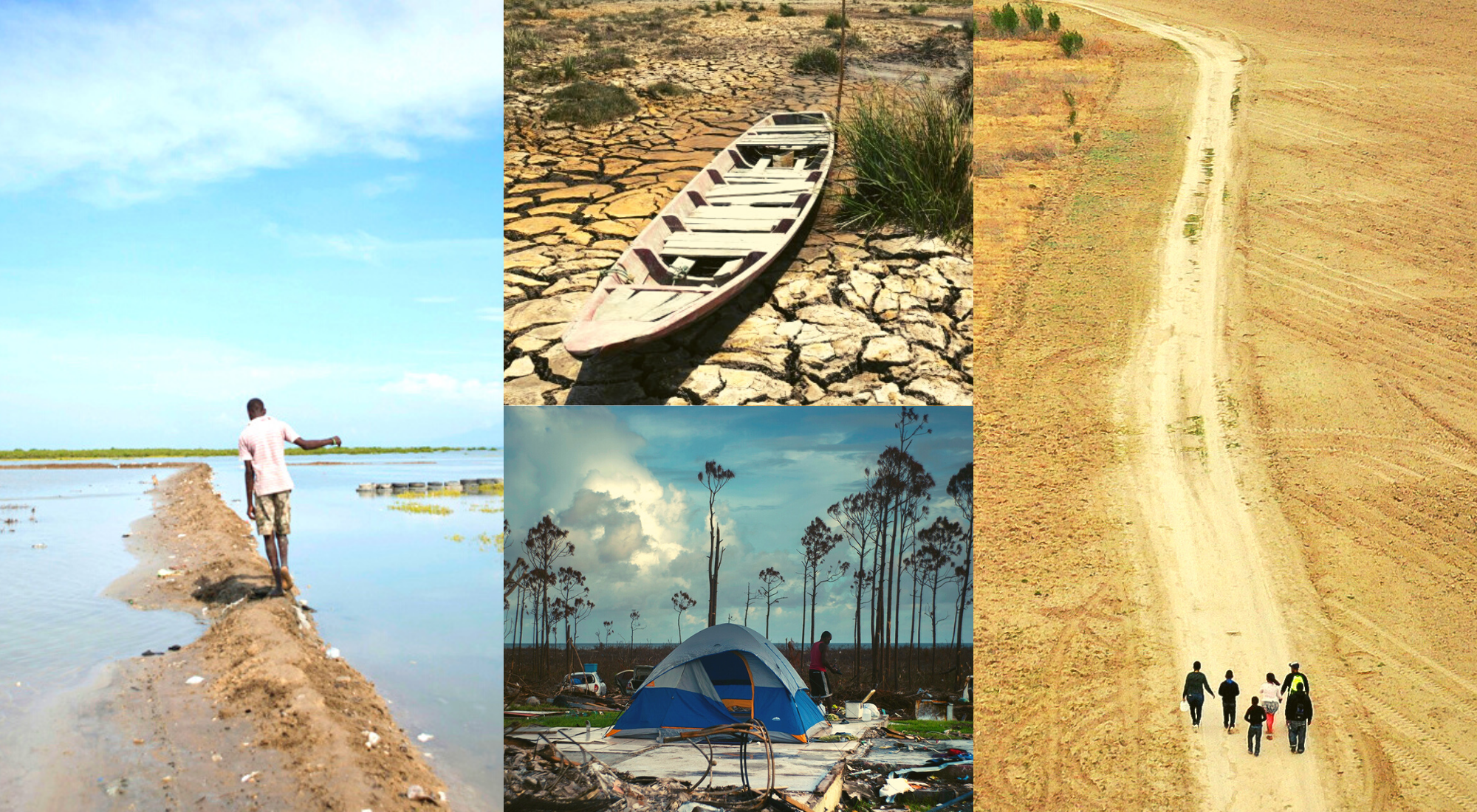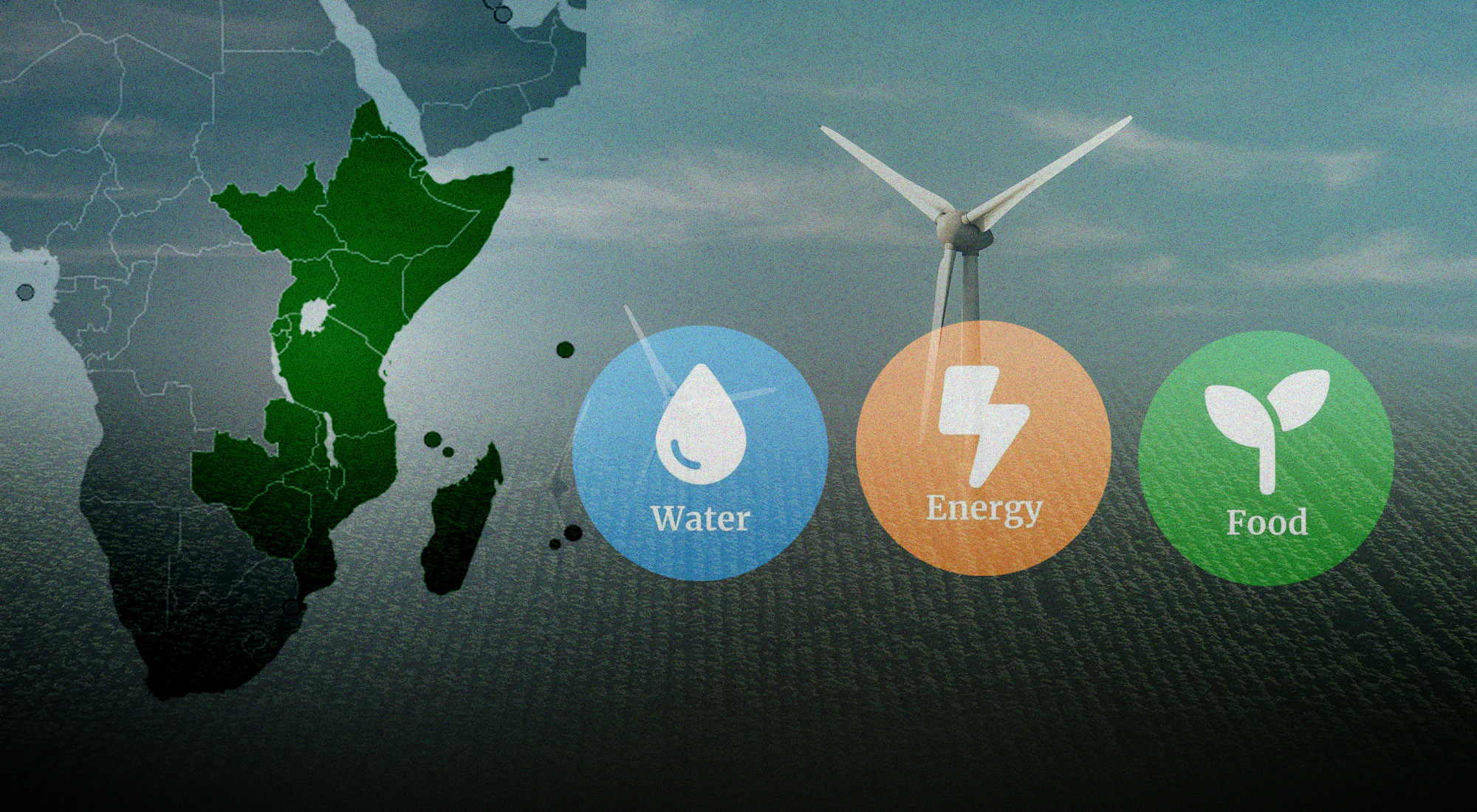Who are Climate Refugees?
The refugee phenomenon in the Twentieth Century was largely defined by the experience of wars, revolutions and dictatorships. In the current century, there is good reason to believe that a major new factor in refugee movements will be the effects of climate change. A good illustration of the shift are the statistics compiled by the Internal Displacement Monitoring Centre (IDMC), a leading global authority set up by the Norwegian Refugee Council. In their report for 2020, they estimated that an updated global total of 40.5 million new internal displacements defined as people forced from their homes, but remaining within their country’s borders. Of these, just 9.8 million displacements were a result of conflicts and violence, while 30.7 million were a result of environmental disasters.[1]
As the report highlights, even this figure may underestimate the problem, as many people will have remained in their homes that year in spite of disasters purely because of the additional risks and restrictions imposed by the Covid-19 pandemic. It is also worth noting that the impacts are being felt now in some of the poorest countries in the world (4.4 million in Bangladesh in 2020) as well as some of the richest (1.7 million in the USA in 2020).
The impacts of climate change are usually divided into two types: sudden and slow-onset disasters. Sudden disasters, such as severe hurricanes, flash floods or wildfires, are obvious and easy to identify as causes of forced displacement. In these cases, there will usually be an influx of support from states, NGOs or aid agencies, either in the form of mitigation such as fire services and anti-flooding measures or relief including medical assistance, temporary shelter, food and water. Slow-onset disasters, as the name suggests, are progressive over time. The gradual loss of habitable and farmable land to drought, coastal erosion or sea level rises takes place over years. As such, the people affected will not suddenly wake up to a situation in which they are forced to flee; instead life will become progressively more difficult in multiple ways to the point at which a decision is made to leave their homes may be influenced by a number of factors. For example, long before people are starving to death, or their houses are literally underwater, they will likely make a calculated decision to move to mitigate harsher living conditions and avoid the catastrophic future that awaits them if they stay.
With slow-onset events there is rarely the kind of dramatic occurrence that might engage the attention of national or international agencies who can support those affected, nor is there an obvious basis on which they can seek asylum in other countries. Moreover, because the effects of slow-onset climate change will gradually lead to economic difficulties, shortage of land, political instability, and many other problems, the extent to which people are moving because of climate change itself or due to its secondary effects may not always be clear. This is compounded by climate change often exacerbating pre-existing environmental hazards: for example, hurricanes are endemic to the Caribbean and flooding to parts of South Asia, but have become much more common and destructive than before. In such cases, to what extent can it be determined that people fleeing these types of disasters in those regions are doing so specifically as a result of climate change?
Climate change is also presenting the world with a novel legal and practical problem: the complete physical disappearance of states. This is no longer a distant or purely speculative phenomenon. Kiribati is one of a number of island nations in the Pacific that are considered the ‘canary in the goldmine’ in terms of assessing the impacts of climate change on forced displacement. For the past 30 years, increased flooding and coastal erosion in smaller, more low-lying islands have caused people to move to the larger and more secure islands within the Kiribati archipelago. As a result the main islands have become overcrowded, fresh water sources have been contaminated by seawater leading to the spread of diseases, and the economy has suffered. These impacts have, in turn, led to increased violence as land disputes have become more common.[2] At the current rate of sea level rise, some are warning that Kiribati, which has a population of around 124,000, will become completely uninhabitable in around 10-15 years time.[3] Where will they go? Or perhaps, more accurately, where will they be allowed to go? And if they manage to secure a life elsewhere, what kind of rights will they enjoy there? Will they be able to continue their cultural traditions and retain political autonomy on the territory of another state?
The debate on terminology
Questions over causation, and the nature of movement resulting from climate change, have inevitable consequences for how the phenomenon should be described. The most common term used amongst intergovernmental organisations such as the UN High Commissioner for Refugees (UNHCR) and the International Organization for Migration (IOM) is ‘climate-induced displacement’. This terminology avoids identifying climate change as being the only, or even the most important element in causing people to leave their homes. It also avoids the tricky question of whether the people moving are ‘refugees’ or ‘migrants’.
In international law, ‘refugee’ is commonly understood to have a fairly precise meaning, located in the 1951 Refugee Convention. This insists that a refugee must demonstrate evidence of persecution on grounds of one or more of nationality, race, religious belief, political opinion, or membership of a social group.[4] Obviously, hurricanes, floods and droughts do not ‘persecute’ anyone in particular. Moreover, many states are very nervous about conceding any extension to this definition, as refugee status is one of the few means by which states can lose their absolute discretion in deciding who can or cannot remain in their country. This is partly why there is almost no mention of climate change in the Global Compact on Refugees,[5] agreed by the UN General Assembly in 2018, even though the issue is referenced substantially in the companion Global Compact on Migration.[6] Some aspects of this latter Compact are discussed further below.
However, the 1951 Refugee Convention is not the last word on the term ‘refugee’. The UN Relief and Works Agency supports Palestine refugees who are defined not by persecution but on the basis of patrilineal descent from those forced to flee their homes in the conflict resulting from the foundation of the State of Israel and the occupation of the West Bank and Gaza.[7] The Organisation of African Unity Refugee Convention of 1969 extends refugee status to those fleeing the effects of military aggression, foreign occupation and events seriously disturbing public order.[8] That last set of criteria potentially opens the door to situations in which the severity of climate change impacts lead to a breakdown in basic infrastructure.
There is also a political dimension to the distinction between a ‘migrant’ and a ‘refugee’. The former is typically understood to be exercising a more or less free choice in moving to another country, and thus less deserving of a right of movement. In contrast, a ‘refugee’ is conceived of as a person forced to leave their home due to circumstances beyond their control, and who thus is justified in demanding a right of asylum elsewhere. It would seem perverse to align those whose homes and livelihoods are threatened by the cataclysmic effects of climate change with people moving simply to take up a new job or to join a spouse abroad.
A further issue is that by linking the concept of forced movement encapsulated by the term ‘refugee’ with the phenomenon of climate change, we are not just describing the victims, but also pointing towards those responsible for assisting them, namely those states that are most responsible for the causes of climate change. It is a striking fact that peoples who are experiencing the severest effects of climate change are in countries with some of the smallest contributions to carbon emissions, including the Pacific island states, sub-Saharan African countries, and Bangladesh among others. Arguably, the Global North bears both the greatest responsibility for climate change and the greatest capacity when it comes to accommodating and supporting people forced to leave their homes in those places.
These are just a few reasons why the concept of ‘climate refugees’ is an appropriate and necessary description. That said, in acknowledgment of the controversial nature of this term, it is also important to note that not everyone who moves as a result of the effects of climate change will consider themselves to be a ‘refugee’. Indeed, there will be many who move early to anticipate the kind of slow-onset effects discussed above, and are able to avail themselves of work, study or other opportunities more akin to standard migration than forced displacement. The key point is that for the many others who do not have those opportunities, and/or who are forced to move in a far more disruptive way, the avenues for legitimate movement open to them are very limited.
The legal framework: deficiencies and prospects
A. A regulatory hole?
The international legal framework addressing climate-induced migration is often described as a ‘legal hole’.[9] This ‘legal hole’ mainly results from several deficiencies: First, as already mentioned above, climate refugees are not ‘refugees’ as they are omitted from the 1951 Refugee Convention.
The second deficiency is related to the United Nations Framework Convention on Climate Change (UNFCCC). For many years, the international community did not address climate-induced migration as part of the international legal framework on climate change. The elephant in the room, however, became too big to ignore, and from 2010 this topic gained greater salience in international climate discussions.[10] The UN member states even established an international Task Force in 2015 “to develop recommendations for integrated approaches to avert, minimize and address displacement related to the adverse impacts of climate change”.[11] To date, however, these efforts have not borne any significant fruit: no significant decisions have been made and the climate refugees remain “under discussion”.
Other efforts to promote and address the situation of climate refugees are also being made in other fora. Importantly, in 2018, the United Nations General Assembly issued the Global Compact for Safe, Orderly and Regular Migration, which recognised that climate change is a significant cause of displacement.[12] This official recognition appears modest and it certainly did not add much in terms of rights and obligations. The General Assembly did, however, create the ‘International Migration Review Forum’ to ensure follow up and review.[13] The Forum was to serve “as the primary intergovernmental global platform to discuss and share progress on the implementation of all aspects of the Global Compact”.[14] This review mechanism requires the member states to meet every four years, ensuring an ongoing dialogue and keeping open the possibility for future initiatives. The International Migration Review Forum therefore represents a step forward, especially given that the topic of climate refugees was entirely absent from any international agenda or forum only a decade ago.
Provisions for the regulation and protection of climate refugees nevertheless remain fragmented and incomplete. There is no dedicated treaty to address the situation of those having to move due to climate change, and existing legal frameworks have, by and large, failed to address this situation in a clear and decisive manner. The picture, however, is not entirely pessimistic. There is no doubt that the topic has now been established on the global agenda and is under active consideration within several major international fora.
B. Courts to the rescue?
The law relating to climate refugees is evolving not only through international negotiations but also, perhaps primarily, through courts’ decisions. Most notably, the United Nations Human Rights Committee (HRC) issued in 2020 what many have regarded as a seminal decision in the case of Teitiota, which involved the appeal by a Kiribati man against a New Zealand government decision not to grant him asylum on the basis of climate change.[15] The case as heard by the HRC explicitly linked human rights law to the situation of climate refugees. Importantly, the HRC decided that in cases where the more severe impacts of climate change result in a threat to one’s right to life, states are under an obligation not to send refugees back to their environmentally depleted countries.
Many celebrated the Teitiota case was celebrated by many for developing the law and stressing the link between human rights law and climate-induced migration.[16] One should note, however, that this case also revealed the limits of human rights law in this context.[17] The petition itself was rejected, with the HRC setting an extremely high threshold for future applications. On the basis of this decision the environmental situation faced by individuals must be extremely dire for an application to be successful, long after their daily life has been rendered harsh and dangerous. This decision therefore effectively forces many potential climate refugees to stay put and experience the slow yet sure process of environmental decline until the complete environmental destruction of their homelands is practically inevitable. Only then would their right to life will be regarded as worthy of protection.
The United Nations’ Committee on the Rights of the Child (CRC) made another important decision more recently in 2021.[18] This specific case pushed the boundary on the issue of extra-territoriality. The reality is that climate-induced migration is happening primarily in the Global South, very far from the territory and direct responsibility of major polluting nations. This situation has allowed for a too-convenient defence, according to which states are responsible for protecting only the human rights of those living within their territorial jurisdiction and physical reach. Climate refugees, accordingly, are not the concern of major polluting nations and do not deserve their protection. The CRC stressed in this respect that in the context of climate change, carbon emissions produced in one part of the world could affect the human rights of individuals residing elsewhere. The Committee explained that polluting nations could no longer hide behind the defence of extra-territoriality and that their responsibility towards protecting climate refugees’ human rights – even of those people residing in a different part of the world – is now far more established.
Conclusion
Climate change is an increasingly important factor in asylum cases around the world. In terms of individual cases, the impact of courts’ decisions as yet has been more tacit rather than meaningful in terms of actual results. In short, studies have shown that states’ asylum tribunals are increasingly addressing environmental considerations in their decisions.[19] It is important to note that environmental factors are being considered in these cases alongside other conditions and are mostly playing only a supporting role. To the best of our knowledge, environmental considerations have never been relied on successfully as a sole reason for justifying an asylum application. However, the fact that courts are increasingly acknowledging and relying on environmental considerations is telling. Future cases will shed more light on whether this trend will continue to evolve and whether, perhaps, the first successful climate-based asylum application may already be underway.
In the meantime, the law on climate refugees, whether looked at globally, regionally or locally, remains fragmented and unclear when it comes to ensuring the right of climate refugees to seek asylum, long-term protection and a continued life
References
[1] IDMC, Global Report on Internal Displacement 2021, available at https://www.internal-displacement.org/global-report/grid2021/
[2] Kenneth R. Weiss, ‘The Making of a Climate Refugee’, Foreign Policy (28 January 2015), available at https://foreignpolicy.com/2015/01/28/the-making-of-a-climate-refugee-kiribati-tarawa-teitiota/
[3] UN Human Rights Committee (HRC), Ioane Teitiota v New Zealand (advance unedited version now available: 23 September 2020) UN Doc CCPR/C/127/D/2728/2016 (7 January 2020).
[4] Article 1A (2), UNGA, Convention Relating to the Status of Refugees, 28 July 1951, United Nations, Treaty Series, vol. 189, p. 137.
[5] UNGA, Global Compact on Refugees, UN doc A/73/12 (Part II) (2 August 2018)
[6] UNGA, Resolution adopted by the General Assembly on 19 December 2018, Global Compact for Safe, Orderly and Regular Migration A/RES/73/195 (11 January 2019).
[7] https://www.unrwa.org/who-we-are
[8] Article 1(2), Organization of African Unity (OAU), Convention Governing the Specific Aspects of Refugee Problems in Africa (“OAU Convention”), 10 September 1969, 1001 U.N.T.S. 45
[9] Sumudu Atapattu, ‘A new category of refugees? ‘Climate refugees’ and a gaping hole in international law’, in Simon Behrman and Avidan Kent (eds) ‘Climate refugees’: Beyond the legal impasse? (Routledge 2018) 34.
[10] UNFCCC, Decision 1/CP.16, FCCC/CP/2010/7/Add.1 (15 March 2011), para 14(f).
[11] UNFCCC, Decision 1/CP.21, FCCC/CP/2015/10/Add.1 (29 January 2016), para 49.
[12] UNGA, Resolution adopted by the General Assembly on 19 December 2018, Global Compact for Safe, Orderly and Regular Migration A/RES/73/195 (11 January 2019).
[13] Ibid, para 48.
[14] Ibid, para 49(b).
[15] UN Human Rights Committee (HRC), Ioane Teitiota v New Zealand (advance unedited version now available: 23 September 2020) UN Doc CCPR/C/127/D/2728/2016 (7 January 2020).
[16] L Baker, ‘World needs to prepare for “millions” of climate refugees – UN’, Financial Post (21 January 2020) available at .
[17] For further analysis of this case, see Simon Behrman and Avidan Kent, ‘The Human Rights Committee’s decision on the case Ieoane Teitiota v New Zealand: Landmark or will-o’-the-wisp for climate refugees?’ (2020) Questions of International Law http://www.qil-qdi.org/the-teitiota-case-and-the-limitations-of-the-human-rights-framework/#_ftn2 .
[18] UN Committee on the Rights of the Child, Sacchi et al v Argentina and four similar cases CRC/C/88/D/104/2019.
[19] Camilla Schloss, ‘The role of environmental disasters in asylum cases: Do German courts take disasters into account?’ in Simon Behrman and Avidan Kent (eds) Climate refugees: Global, local and critical approaches (CUP, forthcoming 2022).









